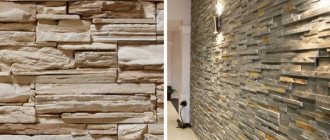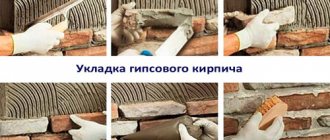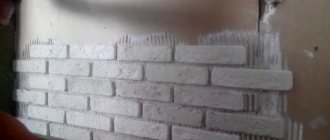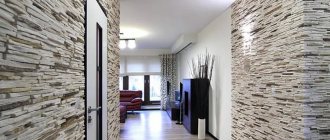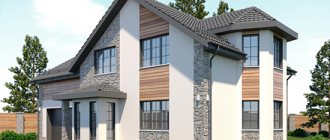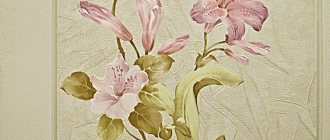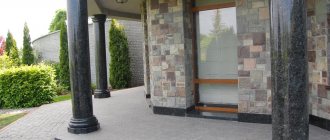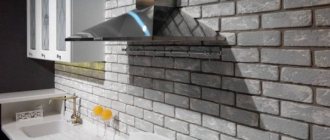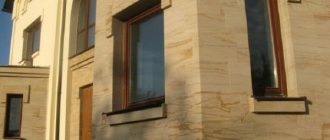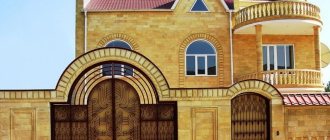It is possible to use decorative brick for interior decoration to give the interior a stone look; this is a kind of immersion in the Middle Ages in one case, if the stone is stylized, or a classic today.
The price of decorative brick for interior decoration is slightly higher than that of traditional wallpaper, but the end result is much better. This interior has become widespread due to the quality of the material, high aesthetics and performance characteristics.
Traditionally, stone is used as a worthy alternative to natural materials, and this is well deserved, since the preparation technology implies 100% safety of the product.
At the same time, the option is quite economical, although somewhat more expensive than wallpaper, but lower than building a structure entirely from brick or purchasing slabs, special tiles from rocks. It also allows you to protect the room from excessive temperature conduction from the outside, and protects the wall itself from excess moisture.
What is artificial stone
And “cold” granite and “majestic” marble, and “warm” sandstone and “simple” slate will become the starting point in the design project. This definition includes material that is specially processed in shape and intended for finishing a room. Both natural and decorative stones are used for interior decoration.
The list of decorative stones is limited to the following:
- marble;
- granite;
- slate;
- sandstone;
- travertine.
All these are rocks mined from the earth's crust. They have a magmatic, sedimentary nature of formation. Their price is high, but it is determined by the complexity of mining and processing the rock.
An alternative to natural stones is artificial for interior decoration. Modern production technologies make it possible to achieve not only absolute similarity in texture and shades, but also to impart properties lacking in natural minerals:
- plastic;
- lower specific gravity;
- high salt and acid resistance.
Advantages and disadvantages
Exterior stone has both advantages and disadvantages. The advantages of this material include:
- quick installation without prior professional training;
- light weight compared to cement tiles;
- Possibility of mounting on drywall;
- wide price range of product options;
- high degree of fire resistance;
- safety for human health;
- thermal conductivity;
- soundproofing;
- many variations of textures.
However, there are some nuances that can be considered as disadvantages of the finishing material. Compared to natural materials, tiles are less durable and resistant to physical abrasion. Some samples do not tolerate direct sunlight, chemical treatment and sudden temperature changes.
Decorative stone for interior decoration - its application
Decorative stone for interior wall decoration has its own rules for use, restrictions and installation specifics. It goes well with wood, metal, smooth or textured plaster for painting (see also decorative plaster).
- The combination of different breeds complicates the perception. A combination of stones of the same type with different surface treatments and shades is allowed.
- If the project does not provide for bright lighting in the room, limit yourself to a small amount of this resource in the decor and use light-colored stone with a large texture. Directional light favorably emphasizes the texture of the stone and the seams of the masonry.
- Most finishes are used to cover all walls of a room. Too much of it turns the room into a stone bag. For this reason, wall decoration requires moderation and a professional design approach.
In the recreation area
Which to choose
When choosing a facing material, you must first take into account the overall style of the room. You need to follow some recommendations:
- for rooms in dark shades, it is better to use finishes in light colors;
- facing materials of blue, gray or green colors should not be present more than 2/3 of the wall height , otherwise the space will visually appear smaller and the furnishings will become heavy;
- the transition between finishes of different colors should be smooth and neat;
- Clients are provided with stones with different corrugations . Lightly ribbed materials are suitable for any design. With strong corrugation they require proximity to modest decorative elements.
Directly when purchasing, you need to pay attention to the availability of certificates, the absence of which may mean low quality products. If the purchase is not made online, then you need to carefully examine the cut, where the structure of the material will be visible. It is recommended to choose a material with small elements; large ones will catch the eye. The frost resistance index should be taken into account; the higher it is, the longer the service life. Other recommendations are presented in the following video.
Advantages and disadvantages
Thanks to the improvement of production technologies, this product is superior to natural products in most respects. The “appearance” of artificial stones for wall decoration is created in sculpture workshops. Chip lines, cracks and delamination profiles are not simply copied from natural stone. Sculptors emphasize individual details, giving them greater expressiveness.
This collection is a work of art. Leading domestic manufacturers are launching mass production of collections with a unique original design up to 6 square meters. Each element in the collection is given a unique contour geometry.
With built-in fireplace
| Advantage | Description |
| Reasonable price. | From the extracted rock mass, the commercial yield of high-quality natural stone is about 40%, which directly affects its cost. The production of artificial decorative stone is waste-free. |
| Less specific gravity. | This is essential when preparing the base and installing it. Unlike natural finishes, installation of supporting structures is not required. |
| Ecological cleanliness. | According to the standards, it is quite acceptable for interior decoration. The absence of increased background radiation allows the stone to be used in a children's room and bedroom. |
| Long service life. | Due to the resistance of the coloring pigment to exposure to sunlight, it does not lose color. Unlike natural stone, artificial stone is not processed to protect it from absorbing moisture and dust. |
| Strength characteristics. | The artificial material has high strength and abrasion resistance. |
| Convenient installation. | The artificial analogue can be easily trimmed during installation. When laying, you do not need expensive and complex cutting equipment. |
Modern technologies make it possible to achieve absolute imitation of the texture of natural resources. The ability to add different shades simplifies the design task of arranging and combining color schemes in the interior.
Where used: in the apartment and not only
Artificial stone finishing harmoniously complements rooms of various purposes in apartments, houses and cottages. Finishing is actively used in offices, commercial, administrative and public premises . The use of artificial stone allows you to create a special atmosphere and demonstrate your refined taste. As a result, there are no strict restrictions on use.
Interior gypsum tile MONTE ALBA York Brick white. Photo by Maxidom
But you need to be able to stop in time so as not to overload the space or make the room too bright or tasteless. Decorating corners, doorways and arched openings looks great, which allows you to achieve not only an artistic effect, but also protect vulnerable areas from mechanical damage. Artificial stone is usually placed in niches, which makes it possible to place a bright emphasis on individual elements of the space. The environmental friendliness of the materials allows them to be used in children's rooms and bedrooms, and to decorate bed headboards.
In the hall
In the hallway it is possible to use various types of artificial materials: gypsum, porcelain stoneware, wild and flexible stone, clinker brick. Stone is used in the hallway either to decorate the entire wall (walls), or only part of it . An arch, corner, niche, doorway or other tiled element will become more expressive .
Finishing on internal and external corners and surfaces near the stairs performs decorative and practical functions, as it protects the walls from abrasion and damage.
The chaotic arrangement of artificial tiles makes the space original.
With the help of finishing it is possible to focus attention on the mirror and lighting.
Full finishing gives the space elegance, beauty, and chic. However, overuse of the material can make the hallway gloomy and heavy. Therefore, partial finishing is recommended. A bold decision is to finish the ceiling . Stone masonry flooring is a long-lasting, high-performing floor covering that is easy to maintain.
There are several recommendations when choosing stone and arranging decoration in the hallway:
- Using materials in warm colors will avoid creating a gloomy room.
- Choosing light colors allows you to fill the room with light and make it visually more spacious.
- Finishing a small space with small tiles visually increases the size of the room.
- For finishing surfaces with complex configurations, flexible stone is ideal, the sheets of which can be easily bent and cut.
- It is not recommended to complement the stone with other decor: paintings, photographs, etc., since it is a self-sufficient means for decoration.
- The natural warmth of wood perfectly sets off the coldness of the stone, so the materials harmonize perfectly.
Kitchen
Stone with a smooth and textured surface is suitable for kitchen decoration . To emphasize a certain area, it is recommended to use materials of different texture, color, and size. Proper combination of stone with other types of finishing allows you to achieve a space that is spectacular in design and practical in use.
In the kitchen, stone is used to design doorways of various shapes, which allows you to visually increase the space. Especially if it is an arched opening and the decoration is made in light colors. This solution is effectively complemented by lighting in the form of sconces or candle candelabra . It is possible to play with contrast by decorating a doorway or arch with dark stone, while the wall around it should be made in a light color.
The dining area , also intended for relaxation, is successfully decorated with warm-colored stone. But this finishing option is possible only in those interiors in which the style does not require the use of cold shades: minimalism, hi-tech, cubism, constructivism.
A bar counter or half partition , which serves to zone the space, is decorated with stonework for greater effect. Prime is suitable not only for spacious rooms, but also for medium and small rooms.
The most common solution is an artificial stone apron ; the ideal choice is a smooth agglomerate. But it is not recommended to choose textured products, they are impractical. The coating is exposed to high temperatures, vapors, and splashes, which are difficult to remove from the relief surface. Smooth products are appropriate here.
The design of corners is carried out according to a similar principle as the decor of arched or doorways. Light walls are complemented by dark tones. The smooth stone coating looks harmonious with textured plaster. The decor of corners often extends into the decoration of walls or openings, unifying the space. Stonework harmoniously combines with paper and vinyl wallpaper. Stone decor and wallpaper with photo printing or airbrushing look beautiful.
Balcony
Full cladding is not typical for the design of balconies and loggias. But if desired, it is possible to decorate the entire room. However, there is a rule - the larger the finishing area, the lighter the shade you need to choose. Cold (non-insulated) rooms are partially tiled; a popular solution is when the finishing is on the wall adjacent to the room. The finishing of an insulated balcony can be complete or partial.
Stonework is used as an accent, which is combined with painted or plastered walls , possibly combined with cork or liquid wallpaper. A correctly selected shade for partial finishing can visually enlarge the space. A small room can be enlarged using horizontal stone masonry made of tiles in white, gray, and beige colors.
A practical and beautiful solution is finishing corners and slopes . The coating hides unevenness and protects against mechanical stress. Finishing the slopes allows you to organically fit the window into the overall design or visually highlight it. If the balcony is connected to the adjacent room by an arch, then a good solution is cladding the arched structure . It is possible to finish the entire opening, or only part of it. But it is important to choose a material that will harmoniously unite two rooms with color and/or texture.
Other premises
1) Bathroom. Artificial stone is non-slip, so it is excellent for flooring in wet areas. Visually, the material can imitate various natural rocks : marble, granite, travertine, etc. For decoration, not only standard facing tiles are used, but various partitions and countertops , seamless coatings for sinks and bathtubs made of acrylic stone and porcelain stoneware.
Porcelain stoneware, concrete textures, and brickwork can highlight the aesthetics of the room Combining them with metal, glass, and bright colors allows you to get fresh and unusual combinations.
A bold solution is a stone bathtub or sink . Plumbing fixtures made of acrylic stone are an excellent analogue of marble products. It looks no less impressive, is not inferior in practicality, will give a lot of positive emotions from use, and the price will be a pleasant addition.
Another element for the bathroom can be a countertop ; it will allow you to personalize the interior.
The standard solution is wall cladding . To do this, it is recommended to choose a thin stone without large inclusions and with a fine texture that does not weigh down the space. Decorating with dark-colored stone is inappropriate; the room will resemble a crypt; this advice is especially relevant for small rooms. If you choose a black stone, then you need to complement it with materials of light shades, the latter should be given preference.
It is not recommended to completely tile small bathrooms, i.e. all the walls. For finishing, you need to select small areas : part of the wall, decorating a niche, lining the bathroom, finished sink, etc. When choosing artificial materials, you must remember that they obscure the space and make it gloomy. Therefore, it is necessary to consider the lighting system , since one light source is not enough. It is recommended to create multi-level lighting, which will make corners and niches bright.
2) Living room. The size of the room plays a determining role. In small rooms, finishing is used locally , otherwise the interior will look gloomy and overloaded. For large-scale cladding of walls or fireplaces, space is required. A beautiful and traditional solution is to decorate the fireplace area if there is a fireplace in the room. In cold weather, the stone cladding heats up from the fire and radiates heat into the room for a long time. In summer it heats up very slowly, which helps keep the room cool. The color scheme for the fireplace is discreet: gray, black, beige . White color is suitable for small spaces.
Flexible stone Monochrome-5 in the fireplace lining. Photo PC Flexible Stone
Contrasting solutions, active patterns and textures are suitable for fireplaces in country houses with sufficient space. Artificial stone is used to decorate fireplace portals and shelves, arched structures, niches, and shelving.
It's rare that a living room is complete without a TV or home theater . This area is also decorated with stone. This can be a complete finish of the wall behind the TV or local cladding . An interesting solution is to imitate gypsum bricks. White is suitable for a small room, red, brown, dark gray - for a spacious one.
Often the floor in the living room is finished with stone, this is especially practical for combined rooms (kitchen + living room).
A technique that is not losing its relevance is masonry with torn edges , which imitates an exposed wall. Combine it with paint or plaster. In this way, corners are decorated, individual elements are highlighted, the room is zoned, and this idea is realized using gypsum tiles.
Wall cladding with flexible stone Classic-1. Photo PC Flexible Stone
3) Bedroom. The entire room or part of it is covered with stone; it is possible to focus on one of the walls , most often, this is the wall behind the head of the bed. It is possible to combine stone with plaster, wood, metal, glass, wallpaper, and fabric. It is suitable for use in interiors of any style. Most often, the stone is mounted on part of the wall, so it is important to think about what the joint will look like . In various rooms, techniques of flow or decoration using torn edges are used; in the bedroom, this finishing method is inappropriate. Therefore, the cladding area must be limited using moldings . In addition to the wall behind the headboard, the decoration of the wall on which the TV is located . Finishing allows you to zone the space, for example, by lining a corner with a mirror and a dressing table.
Classification
The color palette, texture, size and volume of decorative stone collections for interior decoration confuse any novice craftsman.
In the bedroom behind the bed
In reality, there are not many types of stone. There are only three main ones:
- acrylic stone;
- porcelain stoneware;
- quartz stone.
Acrylic
DuPont introduced a composite product called Corian in 1967. When heated to 200 degrees Celsius, the composite became plastic and pliable for thermoforming. After cooling, the acrylic retained its acquired shape and had high strength characteristics.
Acrylic
The advantages include hydrophobicity - water absorption of 0.02%. For comparison, marble has 0.55%. There is resistance to external factors: caustic chemicals, temperature changes, ultraviolet radiation. Acrylic stone weighs less than other types of decorative stones, it is easy to process and can be restored.
Porcelain tiles
The composition of porcelain stoneware is based on a mixture of clay, kaolin, sand and pigments. Shaped porcelain tiles are produced by pressing the composite mixture and firing at a temperature of 1300 degrees Celsius.
In the bathroom
It has low water absorption, impact strength, color depth and resistance to fading under sunlight. When installing it, specially developed adhesive compositions or a metal frame are used. The specific gravity is close to the weight of natural granite.
Quartz
Closest in composition to natural minerals. Consists of 90-93% of natural quartz compounds and polyester resin. The color of the stone is given by the pigments included in the composition. It is produced by mixing components, casting into molds, pressing and hardening in hot furnaces. Its properties are superior to natural analogues. Its bending strength is 515 kg/cm2, while that of marble is 60 kg/cm2.
Quartz
The processed quartz agglomerate is indistinguishable from natural marble or granite, but surpasses them in characteristics.
Description of gypsum
Gypsum decorative bricks for interior decoration also have high-quality technical characteristics, but they cannot be used for exterior use.
By purchasing such a stone, you receive:
- high level of reliability;
- durability of the finish;
- practicality in installation and operation;
- decorative gypsum bricks for interior decoration have a wide range of different sizes and come in a variety of colors;
- resistant to temperature changes.
Many people know that gypsum tends to absorb moisture, which can cause the base to deteriorate and become deformed. So the technology contains an additional layer of protection; varnish is usually used. At the same time, protection helps not only prevent moisture absorption, but also increase the range and quality of the coating.
Plaster
Thanks to the varnish, a matte, glossy, embossed surface is achieved. Additionally, there are effects of convexity or concavity and a feeling of a torn surface.
The size of ordinary decorative bricks for interior decoration can be very diverse; many manufacturers, at their own discretion, provide a choice of shapes and sizes.
It is worth noting that purchasing a brick is not necessary; it is possible to prepare it manually.
The process is quite simple and looks like this:
- The dough is prepared from gypsum , usually bought in a store. You just need to pour in the powder and add warm water to it, the proportion is indicated on the packaging of the specific material;
- preparing molds, these can be any desired shapes and sizes of bricks. There are certain options even on sale;
- the mold is first lubricated with fat and a thickener is added to the mixture;
- it is necessary to pour the gypsum solution into the mold and add pigment to it, mix the mixture;
- For a pleasant visual effect, you can add several colors to the solution and mix a little so that streaks remain. You can mix until smooth. In this case, it is better to use a mixer so as not to fuss for a long time;
- The mixture is set aside until it hardens. Typically, the process of acquiring the required strength occurs within 24 hours;
- to remove the tiles from the molds without damaging them, you must use a rubber hammer;
- Immediately after receiving the gypsum brick, it should be opened with varnish to prevent damage during the installation process.
If you buy the material in a store, the cost of 1 m2 of brick will start from 600 rubles. Usually this includes about 80 pieces measuring 217 x 65 x 8 mm.
Laying on different types of base
Unlike natural stones, artificial ones are much lighter and do not require careful preparation of load-bearing surfaces. There is no need for multi-layer reinforcement of the leveling layer of plaster or the construction of frame structures on weak walls. The preparation of the base for laying stones is carried out taking into account their characteristics. Installation is done on the following bases:
- gypsum plaster;
- concrete;
- drywall;
- tree.
Regardless of the type of coating, distribute the volume of material correctly. After counting, take one stone at a time from different boxes. Otherwise, it will be obvious on your wall where one box ended and the second began.
Gypsum plaster
When starting to lay decorative stone on a previously plastered wall, it must be checked and, if necessary, leveled. The layer of leveling plaster should not exceed 20 mm. If one layer is not enough, level the base by applying the required number of plaster layers, between which lay a reinforcing plaster mesh.
| 1. Prime the wall. | |
| 2. Take a grinder (diamond-coated disc) and grind it. Walk through each block. | |
| 3. Prepare the glue. We recommend using CP 70 aqua in white – it is ideal for this type of work. | |
| 4. Place the first layer on the floor to avoid mistakes. Secure each stone individually. The principle is similar to laying tiles: applying a contract layer after applying adhesive. For convenience, remove any remaining glue with a spatula. | |
| 5. Continue adding layers. Insert a 3-4 mm thick strip between them for a decorative gap. It is important to add small pieces of paper at the top and bottom for easier removal of the wooden spacers. | |
| 6. The finished result. |
Concrete
Placing artificial stone on a concrete wall is permissible 4-5 months after its final shrinkage and drying. Solid concrete does not require additional preparation. The process looks like this:
| 1. Prepare the wall. Apply concrete contact and let it dry. This can be done using a regular paint brush. Complete drying occurs after 2 hours. | |
| 2. Mix the glue in a ratio of 1:5 (kg of glue – glass of water). We do not recommend mixing a large volume at once, as the mixture dries out quickly. After completing the procedure, wait 5-10 minutes. Then stir it again. | |
| 3. Soak the stone with water to reduce absorption. To do this, apply water with a brush or dip it briefly in water and place it on a rag. Otherwise, the material will take all the moisture from the glue, and this will affect the quality of the finish. | |
| 4. Prepare three spatulas. Apply the larger glue on the wall, the smaller glue on the stone, and the wavy one is needed to thin out the surface. | |
| 5. Install a plasterboard or wooden plank 3-4 mm thick and lay the first layer of stone. The strip is needed to lay out an even level. | |
| 6. Once the job is complete, seal the seams with construction sealant. You cannot grout the stone like a tile, as it will be very difficult to wash it later. | |
| 7. After drying, coat with a special varnish or water repellent to protect the surface from moisture and dust. |
Drywall
If decorative stone is laid on a plasterboard wall, the following procedures must be carried out:
| 1. Install the metal profile on the wall. Always start laying such stones from the second row, and grind the first one in accordance with the floor level. | |
| 2. Trim the edges of the stone for smoother joints. If you doubt the adhesion of the surface, then use a primer. Glue only after the wall has completely dried. | |
| 3. Prepare tile adhesive (you can use gypsum). Then make a layer 6-8 mm thick. The thickness of the glue should be medium. | |
| 4. Place the first stone, pressing it to the surface. Remove the glue from above with a thin spatula, holding it at an angle of 45 degrees. | |
| 5. Place the second and subsequent stones, having previously cleaned the edges. | |
| 6. Lay out the second and subsequent layers. This time, apply the glue directly to the stone and remove the excess with a comb. | |
| 7. Insert wedges between the stones to avoid drops and unevenness in the line. | |
| 8. Fit the stone to the corners or floor. If you have plaster, do it with a hacksaw; if you have concrete, then use a grinder. | |
| 9. Finish the laying. After complete drying, remove the wedges and rub the joints. |
Tree
Placing artificial stone on a wooden wall is somewhat different - you must first prepare the surface by applying waterproofing.
| 1. Install the insulation. In this case, roofing felt was chosen. | |
| 2. Install the plaster mesh over the waterproofing. Secure it with construction staples or galvanized nails. | |
| 3. Apply a 1 cm thick layer of plaster. Let it dry for 30-40 minutes. | |
| 4. Apply a layer of concrete contact. | |
| 5. Prepare the glue and lay the first and subsequent layers. Pre-mount the metal profile for the gap between the masonry layer and the floor. | |
| 6. Finally, sand the corners and let the stone dry completely. |
Installation instructions
The process of laying decorative plates under a stone consists of several stages:
- Preliminary preparation.
- Surface preparation.
- Laying facing material.
- Final processing.
Before gluing decorative tiles under a stone, you should make a preliminary calculation of the required amount of adhesive and choose what to glue on.
Surface preparation
If the walls of a building are visually crooked, they must be leveled as much as possible using plasterboard sheathing. To do this, a frame is created from metal profiles onto which the sheets are fixed.
If the walls of the building are not too curved, it is enough to prime them to ensure increased adhesion. However, before priming, it is necessary to eliminate all irregularities, cracks and chips. If necessary, clean the walls of the previous coating before applying the new one.
Bathroom tiling
Wall decor made from plates allows you to create an extraordinary design in rooms with high humidity. The bathroom can be decorated completely or partially: on the surfaces around the sink and toilet. The design of the wall with tiles on which the mirror and shelves are located looks impressive.
Kitchen finishing
In the kitchen, the apron or wall near the stove is tiled. To protect the tiles from moisture, a varnish is used, which not only treats the laid canvas, but also grouts the seams. In the kitchen, both imitation brickwork and stone walls are appropriate. The tiles can be glued around the sink and treated with a protective compound. In this case, the facing material will serve for decades.
Laying floor tiles under stone in the hallway
Not only the walls are decorated with decorative plates imitating natural stone. Floor tiles are used to decorate a corridor or hallway, adding texture and expressiveness to the appearance of the room. Tiles can be used to create an accent around doorways.
Types of drawing
Having figured out how to glue a decorative stone to a wall, proceed to choosing a design. It is easier to navigate the variety of products by dividing them by type of imitation of natural materials. There are three main types of imitation:
- under the tree;
- under a stone;
- under the brick.
Under the tree
A special type of decorative analogue that replicates the texture of petrified wood. It is wood replaced by silica minerals (quartz, chalcedony) with preserved wood structure - annual rings, fibers.
Under the tree
Around the world, petrified wood is of archaeological value. It belongs to the group of semi-precious minerals and for this reason is not an object of interest for use on an industrial scale. Imitation of wood in a decorative analogue is a promising development that has found demand among designers when decorating interior spaces.
Under the stone
These products are divided into three subtypes depending on the simulated texture:
- chopped;
- sawn;
- laminate.
Chip stone imitates the “torn” texture of natural untreated stone. The contour outlines are arbitrary and do not have straight lines. The texture of its front side has an uneven surface, its protrusions are asymmetrical. The mounting side is flat and rough, often with grooves to improve adhesion to adhesive mixtures. Thickness – 20-55 mm.
Chipped
Most often used when decorating in country style. In other styles it is used to give a brutal note. Suitable for interiors where it is not possible to use rocks such as granite, marble, gabbro and others from the igneous family.
Sawn decorative stone replicates the coating of natural materials cut from the rock. It is given a square or rectangular shape. Mainly done in beige, yellow and gray tones, used as a replacement for sandstone, limestone and shell rock. Its thickness is from 20 mm to 35 mm.
sawn
Layered replaces such natural stones of sedimentary rocks as slate, quartz, sandstone. The relief of the stone is distinguished by the greatest depth and expressiveness. Combines harmoniously in compositions of all styles. Elements of the decorative analogue have a thickness of up to 45 mm with a flat or rough base.
Laminate
Under the brick
Decorative stone for interior decoration like brick is the thinnest and lightest of all varieties. Its thickness does not exceed 10 mm, and its weight is 8-10 kg/m2. The stone is perfect for “building” a brick wall in a room where it is impossible to use natural material.
Under the brick
They sell collections of decorative bricks with a skillful imitation of a weathered and burnt surface, with dust embedded in the cracks. Wall decoration creates a certain “effect of village silence” in a city apartment.
Clinker tiles
Clinker tiles are a universal material - they are used for both exterior and interior decoration. For walls, as a rule, they use the thinnest format - 8 mm (although it is redundant for such gentle operating conditions).
Clinker is ceramics made from special refractory types of clay and fired at high temperatures (1400-1450).
Thanks to this, the structure of the ceramic stone is very dense and durable, with high water resistance. In terms of performance qualities, the material is unique, but in decorative terms it is quite limited - clinker tiles mainly imitate brickwork, although the color range and surface texture are much wider than those of ordinary or facing bricks.
The following types of surface textures are distinguished:
- Smooth is the standard option for simulating clinker brickwork in its traditional shades of color. Used for interior and exterior work.
- Glazed - an improved version of smooth tiles, but the resemblance to a brick wall remains only due to staggered laying. Used exclusively in interior decoration.
- Rough is a favorite technique for loft interior style. They are rarely used externally due to the difficulty of care.
- Chopped, tumbled - differs from the previous ones in that it imitates stone masonry of the same size, but with a roughly processed front surface. Quite often used in modern interiors in Scandinavian style, rustic, loft.
Decorating Tips
Wall finishing consists of successive stages:
- Layout of collection elements. On a flat horizontal surface we place the stone in the order in which we plan to mount it on the wall. For ease of use, we mark the elements. Those that will be trimmed before installation should be marked.
- Marking the base for installation. Performed using water or bubble levels. For high precision horizontal and vertical markings, use a laser level.
- Placement of decorative elements. Installation starts from the corner and from the bottom row. Having placed the bottom row, wait for the adhesive layer to dry. Apply the glue, as when tiling, to the wall with a comb spatula in small segments so that the exposed areas of the glue do not harden during installation. When laying, tap with a rubberized hammer to squeeze out air and compact the stone onto the adhesive layer.
- Grouting joints. If the design project involves grouting the joints, do it after the glue has dried. To do this you need to wait 2-3 days. The surface of the stone is porous, so contact with glue or grout mixture should be avoided. To grout joints, buy a special gun.
Work on decorative stone: price per sq. meter
The cost of decorative stone work per square meter varies depending on the object itself and such parameters as:
- Surface area;
- Difficulty in installation.
The final estimate includes a list of work on preparing the base and laying the moldings. Work with corner and shaped elements is assessed separately.
In price lists, work producers usually provide average prices for similar work:
| Name of works | Unit | Cost, rub |
| Installation of artificial stone 230mm*65 180mm*100 (under brick, “sea cliff”, etc.) Interior work. | m2. | 900. |
| Laying decorative material, different sizes, typesetting. Interior work. | m2. | 800. |
| Placement on separate structures, columns, fireplaces, niches and other architectural forms. Interior work, with an area from 0.5m2 to 7m2. | PC. | from 5000 |
| The device was washed on the outer corners of 45º with chip processing. | m/n. | from 150 |
| Making skirting boards from existing material. | m/n. | from 150 |
| Installation of a stone plinth without a decorative corner. | m/n. | from 100 |
Decorative tiles: features and varieties
Any wall tile is a cladding that is designed to protect the main wall materials from external influences and decoration. But tiles made of natural stone and tiles are not usually called decorative - they are easily recognizable and do not imitate other types of finishing materials. And only clinker and some “historically” types of ceramic tiles, due to their characteristics, can be considered decorative, although in catalogs they are usually separated into separate sections.
Trading organizations (online stores and construction hypermarkets) classify as decorative tiles made of gypsum or concrete, the front surface of which imitates brickwork or wall decoration with natural stone. And we can say that all sellers are unanimous on this.
In some cases, 3D panels may be included in this section, since in most cases they are made of gypsum, and many of them are closer in size to tiles than to slabs.
In terms of application, decorative tiles are no different from others, and come in two types: for exterior and interior use.
Decorative concrete tiles are often called artificial stone. And this material is considered universal - it is equally often used for facade cladding and interior decoration.
Gypsum tiles have a narrow specialization - only for interior work.
Manufacturer's choice
A decorative analogue appeared on the Russian market in the mid-90s of the last century. The entire range was exported from Europe and North America. Over time, Russian exporters have appreciated the prospects for investment in the production of decorative products. Most of the exporters of those years today are leading domestic producers.
| Logo | Brand name | For what finish | Cost, rub./sq.m. |
| FORELAND (wild stone) | External and internal | From 1100 | |
| KAMROCK | External and internal | From 1500 | |
| EUROKAM | External and internal | From 1000 | |
| ECOLITH CONSORTIUM | External | From 1200 | |
| LEONARDO STONE | External and internal | From 820 |
Cost of different types of material - table
This table contains various decorative stones. Price per square meter, dimensions, package contents and photos are attached. Choose wisely!
| Photo | Name | Dimensions, mm | Package | Price, rub/sq. meter |
| Frisco 7010 | 210x63x10 | 1 sq.m – 65 pcs (including 8 mm jointing) | 890 | |
| Frisco 7006 | 210x63x10 | 1 sq.m – 65 pcs (including 8 mm jointing) | 890 | |
| Tower 6010 | 31 pieces of irregular shape | 2 sets / box - 0.67 sq.m | 990 | |
| Tower 6009 | 31 pieces of irregular shape | 2 sets / box - 0.67 sq.m | 990 | |
| Spring Hall 5014 | 290x98x20 | In 1 sq.m – 35 pieces | 990 | |
| Spring Hall 5011 | 290x98x20 | in 1 sq.m – 35 pieces | 990 | |
| Rocky Rock 4007 | 100x500, thickness from 10 to 60 | 10pcs/box – 0.5 sq.m. | 990 | |
| Rocky Rock 4008 | 100x500, thickness from 10 to 60 | 10pcs/box – 0.5 sq.m. | 990 | |
| Colorado Slim 2010 | 480x100x15 275x100x15 185x100x15 | in 1 sq.m. - 7 sets (28 pieces) | 990 | |
| Colorado Slim 2006 | 480x100x15 275x100x15 185x100x15 | in 1 sq.m. - 7 sets (28 pieces) | 990 |
Artificial stone for interior decoration - photos of interior solutions
No joints
With lighting
Near the outlet
Combined with wood
On the whole wall
In the home theater
In library
Modern style
Loft style
Combined with plants
Vintage style
Country
